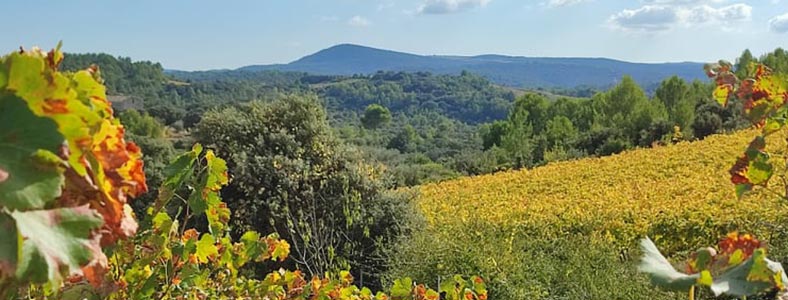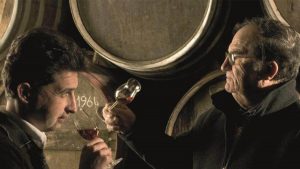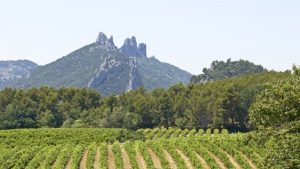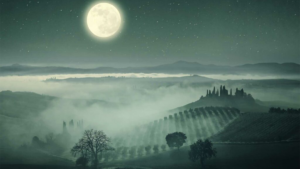
When we can, we like to get out and about in the vineyards, talking to the vignerons that work the land and trying their wonderful wine. Recently, Eloïse from the Buying Team, and Emmanuel who manages Digital Marketing, headed south to the Languedoc. There, they spent a good few days getting to know some regional wine makers, starting with Roman Guibert of Mas Daumas Gassac, and Sophie Guizard of Domaine Saint-Sylvestre.
It’s important to underline, before we begin, the really high quality of each of the properties we visited on our trip. The Terrasses du Larzac appellation completely charmed us with the diversity of its terroirs and the ability each vintner possesses to express the place in their own way.
Crossing the winemaking land of Aniane and its surroundings bathed in sun on a fresh autumn morning, let’s just say we’ve had less enjoyable Mondays. Straight after breakfast, we were on our way to Mas Daumas Gassac, where we were welcomed by Roman Guibert, a son of the domain’s founder, Aimé Guibert.
Mas Daumas Gassac
We started this visit with a tour around the vineyard. We’ll give you a moment to take in the view…
This estate was created from scratch 45 years ago. Aimé Guibert, a glove-maker by trade and originally from Aveyron, was really drawn to the land and the cultivation of it. Moving to the property with his wife Véronique, they didn’t know exactly what they wanted to grow there, just that they’d found a magical place in which to settle down. Henri Enjalbert, a renowned professor from Bordeaux, came to carry out an analysis of the land and its soil, concluding that this was a fine terroir for vine growing. Olive groves and corn rows didn’t get so much as a look in; grapes were the order of the day!
At this point, with Aimé fully sold on the vineyard front (especially with a fine terroir so close to the Côte d’Or!), he brought in another expert. This time it was Emile Peynaud, after whom the winery is named, a well-known figure among oenophiles and an experienced adviser to some of Bordeaux’s finest crus. Upon hearing about Aimé’s project, Emile was intrigued, more than aware of the region’s less-than-enviable reputation at the time, and knowing how much work was to be done for this venture to work out. This was a chance to move away from already successful areas and towards bringing an underdog into the spotlight.
Most of the vine land at Mas Daumas Gassac is planted with Cabernet Sauvignon, not Pinot Noir as its terroir might suggest. The latter tends to become a bit ‘candied’ in such a climate. Bordeaux’s star grape, much better adapted to the environment, also has the advantage of ripening quite late, allowing it to escape the devastating effects of spring frosts such as those that ravaged France this year. Cabernet Sauvignon is also a strong variety to produce cellaring wines, a feature that the wine makers at Daumas Gassac lean into.
The domain covers 150 hectares of garrigue terrain overall, 45 of which are dedicated to vine cultivation. Wild and varied vegetation separates different vine plots and surrounds the domain itself, a pleasure for the eye and nose alike. This is a feature that provides welcome shade to the vines as well as keeping it in a natural state of harmony. With wild plants come predators, too, such as bats that protect the plants from vine worms! Daumas Gassac is currently in the process of getting organic certification, though it must be said that these methods have already been practiced here for several years.
This is an area where the temperature changes greatly from day to night, allowing the resulting wine to keep a pleasant freshness whilst expressing concentrated aromas. We found this in the other estates we visited, too, and it’s a feature that really comes through in the wine. The soil at Daumas Gassac is poor and well-draining, so stresses the vines and forces them to focus their energy on their fruit. There is also a veritable patchwork of grapes grown to make nuanced blends with the Cabernet Sauvignon; we find Cabernet Franc, Tannat, Merlot, Petit Verdot, Carménère, Syrah, Pinot Noir (a lovely vine planted on some of the cooler plots), Viognier, Chardonnay, Petit Manseng, and Chenin!
There’s a novelty aspect to the winery, which has been built in a former water mill, and the wine vats have been placed directly in the old water reserve. The grape juice is first moved only by gravity, avoiding an oxidation of the grapes and protecting them from damage. For the white cuvées, maturation takes place in cold vats (7°C). As for the reds, these wines are matured in casks aged between one and seven years so as to avoid marking them with an overly oaky profile.
After many difficult years spent trying to shake off the region’s reputation as the home of mass-produced, low-quality grape juice, the domain managed to attract some of the most prestigious tasters. Gault & Millau, for example, have declared Mas Daumas Gassac ‘Languedoc’s Château Lafite’…
The wines, a glimpse
We weren’t going to head off without trying some of the domain’s beautiful wines, as well as some with the Moulin de Gassac label. The latter are more accessible wines made from grapes grown by partner vintners; the fruit is then vinified by Mas Daumas Gassac. Overall, there are 25 cuvées in this range. Here are some examples of the ones we got to taste:
White
Moulin de Gassac, Faune: an aromatic wine made from Viognier and Chardonnay. It has body and a certain opulence to it, with aromas of pear and apricot. This is balanced out by a well-measured bitter finale.
Mas Daumas Gassac 2020: discrete on the nose to begin with, this cuvée opens up with beautifully complex aromas of white flowers and apricot. On the palate, it has an elegant minerality with a pleasant acidity. A good wine that can be aged in the cellar for several years.
Red
Moulin de Gassac, Combe Calcaire 2020: a blend of Cabernet Sauvignon and Syrah, matured in casks for a year; it’s lively and powerful, a perfect pairing for grilled dishes.
Mas Daumas Gassac 2019: a lovely fruity profile, leaning on red fruits with structured tannins that suggest excellent ageing potential. A wine that we really enjoyed tasting.
See Mas de Daumas Gassac wines here
After enjoying lunch in Roman’s company, one of the tyres on our all-important vine-exploring vehicle decided it was time to give up. Well, no adventure is without its hiccups…And we still managed to reach our next destination!
Domaine Saint-Sylvestre
A domain perched in the heights of Puéchabon, neighbouring the eponymous chapel, Domaine Saint-Sylvestre is another spot with superb panoramic views. The success of the tasting at Mas Daumas Gassac had us all enthusiastic for more, and Sophie Guizard kindly came to collect us. We were taken through a bucolic landscape of pebbled country roads…rocky terrain that might have brought our remaining tyres to an untimely end if we’d attempted it in our little hire car! It wasn’t easy to take notes en route, so we took it as a sign to enjoy the surroundings as best we could.
The vines at Saint-Sylvestre previously belonged to Domaine de Montcalmès, and they are strikingly beautiful. Every single plant seems well looked-after, and during our visit we got to understand the masterful grafting techniques used, keeping the vines really healthy. This is a reputation confirmed by everything we heard, before and after, from the estate’s peers and neighbours. Aside from the ‘historic’ vines, a parcel was cleared in 2015 to plant some new roots; this plot is named Le Plantier.
Vincent and Sophie Guizard know what hard work is. They manage both the vineyard and the winery between them, as well as building structures on the domain and stone walls on their land. It’s an immense task with impressive results, and we can only respect what they do for their wine estate.
We tasted cuvées from the bottle and the cask (all of the grapes are vinified by variety and parcel), and there’s a distinctive style that runs through the range, as well as a wonderfully silky texture. Many of the casks are enough in themselves to make remarkable wines.
Matured in stainless steel vats to begin with, the wines are moved to their oak casks after a certain period, depending on the judgement of Vincent and Sophie; they don’t employ an oenologue and trust their own taste buds. Once in the cask, the reds age there for two years, the whites for just one, before a bottling process that follows the lunar calendar. Interestingly, these vintners recommend uncorking their wine only when the weather is good, as this is when they best flourish.
A real favourite that we’ll nevertheless be selling come rain or shine (just give us time to receive the wines first 😊)!
The wines, a glimpse
Domaine Saint-Sylvestre red 2020: we didn’t get to taste the wine itself, but rather the different casks that will be blended to make it. Two parcels of Grenache, one Mourvèdre, and a Carignan. It was all strikingly silky, with amazingly softened tannins and a finesse that can already be enjoyed. Superb.
Domaine Saint-Sylvestre white 2020: after 12 months in Burgundian casks, this blend of 45% Roussanne, 45% Marsanne, and 10% Viognier has a lovely texture and a delicately floral side. What lingers on the palate is a pleasant bitterness. A charming cuvée!
Le sang du Papète 2020: from a terroir near Béziers that belongs to Sophie’s grandfather. This cuvée is made from mature Carignan vines. The silkiness is there with pleasant tannins, an ample but precise palate, and a freshness that doesn’t crush its aromatic fruitiness. In short, amazingly balanced.
As you can tell, we really clicked with this region and its wine makers, though we had to deal with our bothersome tyre problem before we could travel on…The next part of our visit began at the crack of dawn, and you can read all about it next week!
Find all of our Languedoc wines here



